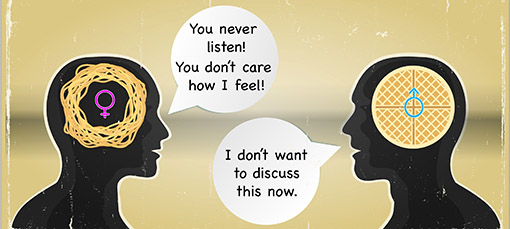
Why is Good Communication so Elusive?
By Cheri Torres
There’s a reason effective communication has remained in the top five issues in relationships and organizations. We treat it like a transaction: I say something, you receive the message and interpret it, then you respond. We point at and blame one another for not communicating effectively, for misinterpreting, or not understanding. With this model, communication becomes a problem to be solved. But, it’s not.
The Foundation of Communication
Consider that we are almost always in conversation with ourselves or others. Language allows us to create meaning in the world, assess experience, and predict. When it comes to our inner dialogue, language is the basis for rehearsing what we’re going to say, worrying about what we said, critiquing what just happened, judging others and ourselves, making up stories, running through possible solutions to problems, assessing the level of threat in a situation, projecting onto others, and worrying about or planning the future. This inner world of dialogue creates a preconditioned mindset, which influences our communication. If we want to improve our communication, mindfulness about the influence of our words and their effect on us and others is essential.
Words Influence Our Mindset
Our nervous system has two primary functions: (1) keep us safe and alive and (2) enable us to connect, think, and create. The first function is dominant. Anytime we are threatened, our nervous system activates our protect functions: fight, flight, freeze, or appease. There is a whole biochemistry associated with this. Stress hormones are released—cortisol, norepinephrine, and testosterone. These hormones boost energy and oxygen to the muscles and away from the higher order centers of the brain: the prefrontal lobe and the neocortex. They also generate an array of emotions, influenced by our thoughts. If we need to flee a saber tooth tiger, this an effective solution. However, it is most ineffective if we are instead facing a boss who’s expressing disappointment in our performance or we need to have a crucial conversation with a child. When we communicate from a place of high stress, fear, anger, etc., we have limited access to the parts of our brain that enable connection, creativity, and higher order thinking. We are bound to communicate ineffectively.
One of the primary threats in relationships and the business world is the threat of being excluded, ostracized, and rejected. Belonging is one of those basic human needs; without the tribe we die. When we have a strong sense of belonging and feel secure in our relationships and position within the organization or the family, it is easier to face stress without getting hijacked into protecting ourselves. This sense of belonging stimulates hormones that shift the brain chemistry in ways that gives us access to the prefrontal lobe and neocortex. A different set of emotions are generated by these hormones: Love, caring, appreciation, curiosity, etc. When we have access to those parts of the brain we can connect with others, access emotional intelligence, be creative, learn, and engage in critical thinking. This is what we most need for effective communication, especially in those stressful situations. So, how do we shift our brain chemistry?
Mindfulness
To foster effective communication means being in charge of your own mindset before beginning to speak.
1. You are in charge. Understand your ability to communicate effectively is influenced by your brain-body chemistry. Understand you are NOT your neurophysiology. You can influence it.
2. Practice awareness. As soon as you experience the need to protect and defend yourself, PAUSE. Take a deep breath.
3. Then, get curious. Ask questions that help you shift the way you are thinking:
• What do I actually want to happen right now?
• What else might explain what the other person said or did?
• What information might I not know?
• What questions can I ask that will expand the opportunity in this situation?
Just asking these kinds of questions changes your brain chemistry. Curiosity is a positive emotion, associated with the prefrontal lobe. When you communicate from this more whole brain place, your communication is naturally more effective. As you access emotional intelligence you are able to relate better; your body language, tone of voice, and words you use are more likely to support connection. Your ability to come from a whole brain mindset supports a shift in mindset for the others in the conversation as well, influencing their ability to communicate more effectively.
Good communication is an “inside job.” Asking questions that generate curiosity, openness, and interest helps us manage our stress response and negative emotions, allowing our natural ability for good communication
to emerge.
Cheri Torres is an author and speaker cheritorres.com. You can download a free Conversation Toolkit and learn more sparking great conversations at ConversationsWorthHaving.today.


